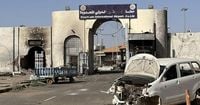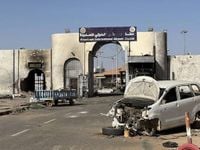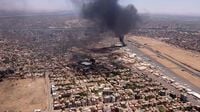For the first time in more than two years, a passenger flight touched down at Khartoum International Airport on October 22, 2025, offering a flicker of hope to a city battered by war and uncertainty. The Badr Airlines flight, arriving from Port Sudan and carrying Sudan’s Sovereignty Council head Abdel Fattah al-Burhan, marked the official resumption of domestic air traffic after a 30-month shutdown—a closure triggered by the violent conflict between the Sudanese Armed Forces (SAF) and the paramilitary Rapid Support Forces (RSF).
The reopening was anything but smooth. In the early hours just before the scheduled resumption, the airport and its surroundings were rocked by a series of drone attacks. According to eyewitnesses cited by AFP, the unmistakable buzz of drones filled the skies over central and southern Khartoum between 4:00 am and 6:00 am, followed by at least eight explosions near the airport. Flames and thick plumes of smoke rose above the city, a stark reminder that the conflict was far from over. The Sudanese military managed to shoot down several drones, but some reached their targets, causing damage to airport facilities and sparking panic in nearby neighborhoods, as reported by Al Jazeera and Sudan Tribune.
Despite the chaos, the Civil Aviation Authority pressed ahead. In a statement reported by Sudan News Agency and shared on the airport’s official Facebook page, the authority confirmed, “A Badr Airlines aircraft landed a short while ago at Khartoum International Airport, announcing the inauguration of the airport and the resumption of air activity from the capital after a period of shutdown. This event represents an important step in the recovery of the Sudanese aviation sector and the gradual return of air traffic.” The reopening, they emphasized, was only possible after completing all necessary operational and technical procedures.
General Abdel-Fattah Burhan, Sudan’s de facto leader and army chief, visited the airport on October 21, 2025, just ahead of the reopening. He delivered a speech vowing to protect citizens from further RSF attacks, stating, as quoted by Al Jazeera, “The military’s duty is to ensure protection and security for all Sudanese. Soon, no one will be able to threaten this land.” The symbolism was clear: the government was eager to show it was regaining control and restoring normalcy to the capital.
But the RSF was not backing down. On October 21, 2025, RSF leader Mohammad Hamdan Daglo Mousa, widely known as Hemedti, issued a chilling threat in a video message: “Any airplane that takes off from any neighboring country, any airplane that is dropping supplies, bombing or killing, any drone that takes off from any airport, will be a legitimate target for us.” This warning came just hours before the drone attacks, highlighting the ongoing dangers facing Sudan’s fragile aviation sector.
The reopening of Khartoum International Airport is more than a logistical milestone—it’s a lifeline for a country in crisis. The war between the SAF and RSF, which erupted in April 2023, has killed at least 40,000 people according to the World Health Organization, and displaced as many as 12 million. Some studies cited by US universities estimate the death toll could be as high as 130,000. The United Nations has repeatedly called Sudan one of the world’s largest humanitarian crises, with more than 24 million people facing acute food insecurity and millions more struggling to access basic health care and shelter.
For Khartoum, the reopening represents a tentative step toward recovery. The city’s airport was one of the first and most strategic sites to fall silent when fighting broke out. The Sudanese Armed Forces only managed to recapture the heavily damaged facility from the RSF in March 2025, after months of fierce urban combat. Since then, the government—led by Burhan—has launched a six-month campaign to rebuild infrastructure and encourage civilians to return. The push to resume domestic flights is part of a broader effort to restore mobility, reconnect supply routes, and eventually lure back international airlines.
Yet, security concerns loom large. The recent drone strikes, which occurred just hours before the airport’s reopening, underscored the risks of renewed violence. Rakoba News and local outlets described the attacks as “an apparent attempt to disrupt the reopening of the airport after more than two years of closure.” Airline sources cited by Reuters and local media initially suggested that the opening might be delayed by several days, but the successful landing of the Badr Airlines flight proved otherwise—at least for now.
Observers say the stakes are high. Civilian aviation is critical for reviving trade, reuniting families, and delivering humanitarian aid to regions cut off by the conflict. Port Sudan, on the Red Sea, has served as the country’s only functioning international airport since the war began, with major carriers like Turkish Air, Egyptair, and Ethiopian Airlines operating there. The government hopes that Khartoum’s reopening will eventually pave the way for the return of international flights, with European diplomats expected to visit the capital by the end of the month and SAF officials urging Western countries to reopen their embassies.
Meanwhile, the conflict rages on elsewhere. Since the SAF pushed RSF forces out of Khartoum in March 2025, the RSF has shifted its focus to the Darfur region, particularly the city of el-Fasher. According to the United Nations, el-Fasher has been under siege for weeks, with markets empty and vital supplies cut off. U.N. Secretary-General Antonio Guterres’ spokesperson, Stephane Dujarric, recently warned that el-Fasher was “under siege from all directions,” with fighting and drone strikes intensifying.
As the dust settles—at least temporarily—over Khartoum International Airport, questions remain about the future. Will the fragile peace hold long enough to restore regular air service? Can the government guarantee the safety of passengers and flight crews in a city still haunted by the specter of drone attacks? And, perhaps most importantly, will this symbolic step toward normalcy translate into real relief for the millions of Sudanese still caught in the crossfire?
For now, the successful landing of a single passenger plane stands as a rare moment of progress in a country desperate for good news. Whether it marks the beginning of a new chapter or just a brief pause in the violence, only time will tell.


